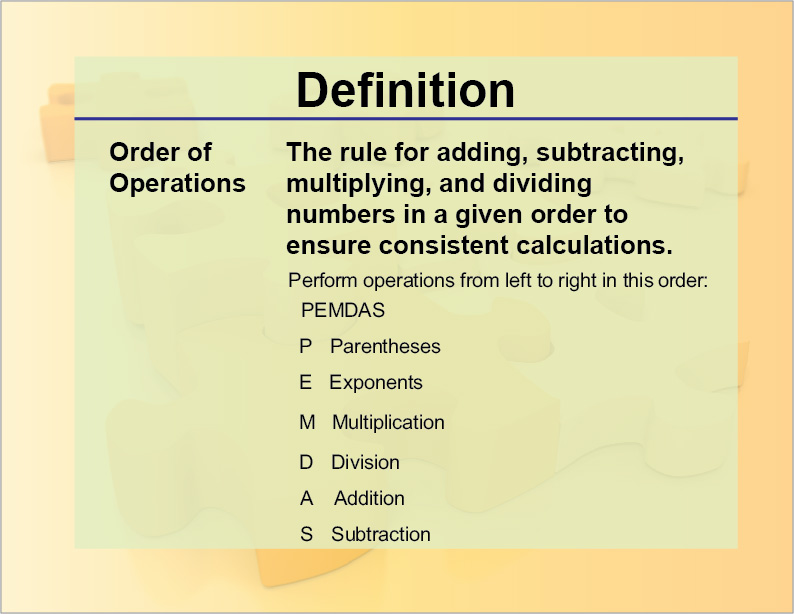Understanding The Importance of Order of Operations
The order of operations, also known as PEMDAS, is an important mathematical concept that determines the sequence in which operations should be performed in an equation. Mastering PEMDAS helps ensure calculations are done correctly and prevents mistakes from ignoring the intended order. This article will break down the order of operations and provide examples to illustrate its significance.
Sequence is Key
Mathematical expressions involving multiple operations require following a defined sequence to arrive at the correct solution. PEMDAS—which stands for Parentheses, Exponents, Multiplication, Division, Addition, Subtraction—lays out the standard order that should be used. Starting with operations inside parentheses first allows the expression to be simplified in a logical progression before moving on to the next operation type from left to right. Ignoring the proper sequence can result in an incorrect final answer. Expressions incorporating different operation types highlight how crucial the order is. For example, in the problem “4 + 3 × 2”, if multiplication is performed before addition as the characters are read left to right, the answer would be 10. However, following PEMDAS, the correct answer is 7, obtained by first doing 3 × 2 to get 6, then 4 + 6 to get the solution. Failing to adhere to the established order can wrongly influence the outcome.

Parentheses Take Precedence
Parentheses serve an important purpose in mathematics—they indicate operations inside should be completed first, before anything else. This allows expressions to be broken into logical groupings that are then solved step-by-step. For example, in the expression “4 x (2 + 3)”, applying PEMDAS means the addition inside the parentheses is performed initially, yielding 2 + 3 = 5. Only then is the multiplication done, giving the final solution of 4 x 5 = 20. Ignoring parentheses can distort the intended grouping and lead to mistaken reasoning as operations are not completed in the designed sequence.
Exponents are Evaluated Next
After any operations surrounded by parentheses, exponents are handled next in the PEMDAS order. This makes sense as exponents raise terms to successive powers, changing their overall value before other operations are applied. For example, in the expression “32 + 4”, following PEMDAS tells us to first evaluate 32, which is 9. Then 4 is added to give the solution of 9 + 4 = 13. Calculating exponents out of order could return an incorrect result. Mastering the proper sequence eliminates ambiguity and ensures the mathematics are performed as structured.
Multiplication and Division are Simultaneous
According to PEMDAS, multiplication and division are completed at the same time, working from left to right within an expression as they appear. For example, in solving “8 ÷ 2 x 3”, both the division and multiplication are handled simultaneously, dividing 8 by 2 to get 4, then multiplying by 3 to reach the final solution of 12. This reflects that multiplication and division have equal precedence and are not strictly in order of appearance. Following PEMDAS prevents incorrectly doing operations in a strictly left-to-right manner, which could result in an unintended solution.
Addition and Subtraction Follow Suit
Like with multiplication and division, addition and subtraction also have equal precedence per PEMDAS and are completed simultaneously from left to right. So in an expression like “5 + 3 - 2”, 5 + 3 would yield 8, and then 8 - 2 gives the solution of 6. Adhering to the proper order prevents mistakenly performing the subtraction before the addition due to position within the expression. Mastering PEMDAS allows expressions to be solved logically and unambiguously.
Examples Demonstrate the Difference Proper Order Makes
Worked examples provide a clear way to illustrate how following or ignoring the order of operations set by PEMDAS leads to divergent results. Consider the expression “4 + 6 × 2”. If PEMDAS is observed, we first do 6 × 2 to get 12, then add 4 to reach 16 as the solution. However, if we calculate left to right without regards for order, we would add 4 + 6 to get 10, and then multiply by 2 for a result of 20—not the intended solution. Another example is “5 × 3 + 2”. By PEMDAS, 5 × 3 is 15, then 15 + 2 is 17. Ignoring order could incorrectly yield 5 × (3 + 2) = 5 × 5 = 25. These differences show why the established sequence must always be adhered to.
Summary
In summary, PEMDAS—Parentheses, Exponents, Multiplication, Division, Addition, Subtraction—outlines the critical order that must be followed when evaluating mathematical expressions involving multiple operations. The sequence ensures calculations are carried out logically and systematically to obtain unambiguous, intended solutions. Examples demonstrate how ignoring the proper order can lead to mistaken outcomes. Mastering PEMDAS involves understanding the flow and precedence conveyed by the mnemonic, as well as practicing applying it to correctly solve expressions as designed. Adhering to the sequence prevents unintentional errors and allows clear communication through consistent calculation.
